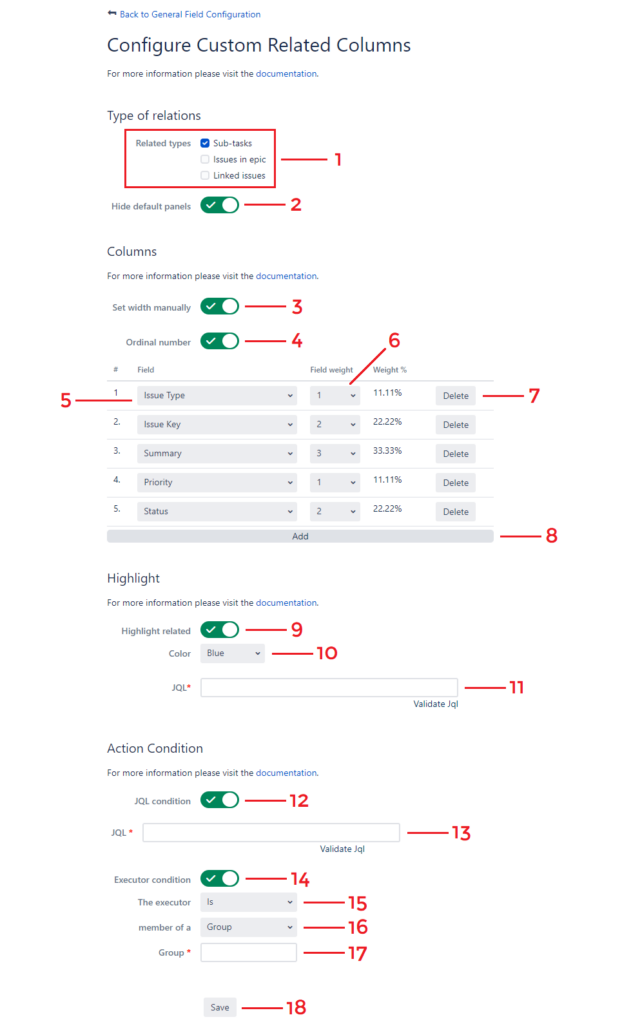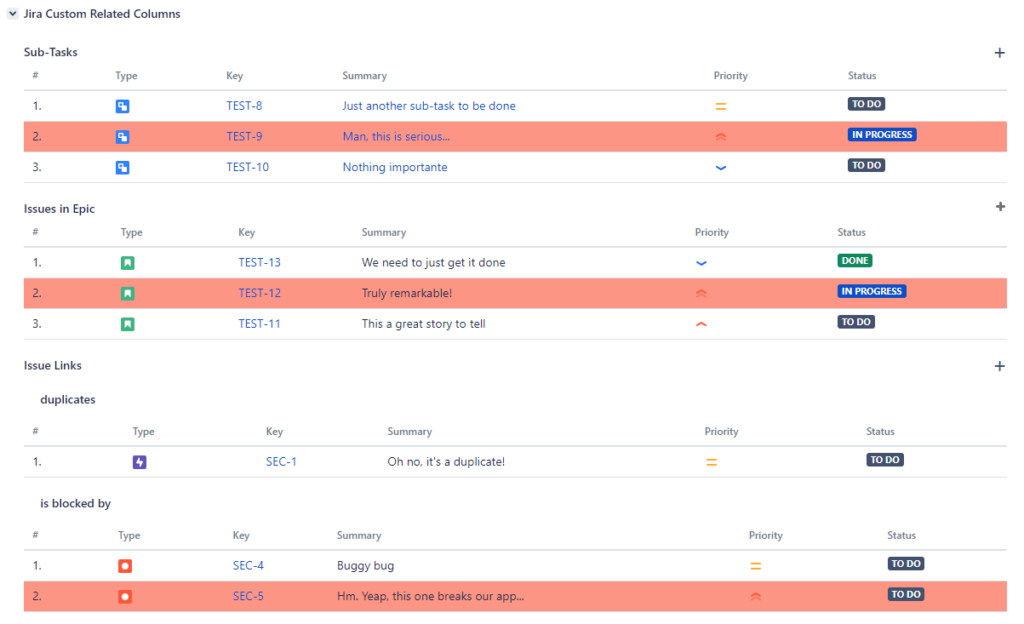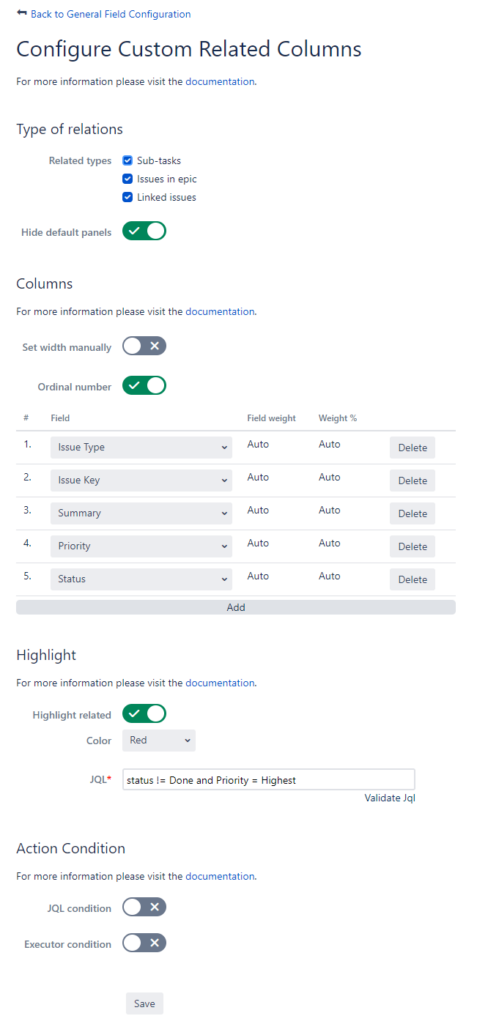JCRC Jira Custom Related Columns
Navigation
-Getting started
-Custom field configuration
-Custom panels issue view
-Support and troubleshooting
Getting started
Overview
Jira Custom Related Columns (JCRC) is a Jira app designed to extend the capabilities of standard Jira issue panels (Sub-Tasks, Issues in epic, Issue Links) for improved visibility. It provides a custom field displayed on the issue view as a custom panel with configurable columns.Installation
Permission required
Remember that in order to carry out the steps described below and install JCNE you have to be a Jira administrator.
From Jira
1. Click the Administration cog icon and select Manage apps2. Click Find new apps
3. Search for JCNE Jira Custom Notification Extension
4. Click the Install button
5.Click the Accept & Install button
From Atlassian Marketplace
1. Go to JCNE Jira Custom Notification Extension page on the Atlassian Marketplace2. Click the Get it now button
3. Go to Jira, click the Administration cog icon, and select Manage apps
4. Click Manage apps
5. Click the Upload app link, select the file downloaded in step 2 and click Upload
Add custom panels
Permission required
Remember that in order to carry out the steps described below and install JCNE you have to be a Jira administrator.
In order to add a custom panel to your issue view follow the steps below:
1. Click the Administration cog icon and select Issues
2. Click Custom fields in the sidebar menu
3. Click the Add custom field button
4. Click All or Advanced in the sidebar menu
5. Select [JCRC] - Jira Custom Related Columns and click the Next button
6. Enter the Name of the custom field (the name of the field is not relevant as it will not be displayed) and click the Next button
7. Select issue types and projects to configure the context of the custom field
8. Click the Create button
9. Select applicable screens and click the Update button
10. Click the … icon from the Actions column of the previously created custom field and select Configure
11. Click the Edit Customized Columns link
12. Select the panels to be visible as custom in the Custom panels field
13. In the Columns section, add custom columns that will be displayed by the custom panel
14. Click the Save button
Next steps
Wondering what to do now? You can explore the rest of the documentation to find out what JCNE has to offer and take advantage of it. However, if you want to hop into action right away, just do it! JCNE is straightforward and user-friendly to let you enhance your processes quickly. If it happens that you need our assistance on any step of your journey with JCNE, just get in touch through our support portal or write a message at support@mintyminds.com.Getting started
After having created the [JCRC] - Jira Custom Related Columns custom field, you should set it up. To enter the configuration follow the steps below:1. Go to Jira Administration → Issues → Custom fields.
2. Click the more […] dropdown menu from the Actions column of the JCRC custom field and select Configure.
3. Click Edit Customized Columns.

Available configuration options include:
1. Related types - select which custom panels will be created.
2. Hide default panels - remove default Jira panels (only the ones selected in Related types) from the issue view.
3. Set width manually - set the width of columns in the custom panel based on the Field weight value.
4. Ordinal number - add the row ordinal number column to the custom panel.
5. Field - field that will be displayed in the custom panel. The order of the fields in the table will be applied to the custom panel on the issue view.
6. Field weight - number that describes the width of the field in relation to other fields in the custom panel.
7. Delete - remove the field.
8. Add - add a new field.
9. Highlight related - show related issues that meet the JQL condition as highlighted.
10. Color - color of the highlight.
11. JQL - JQL query that has to be met by the issue in the custom panel to be highlighted.
12. JQL condition - display custom panels only on issues that meet the JQL condition.
13. JQL - JQL query that has to be met by the current issue to display the custom panels.
14. Executor condition - the condition that has to be met by the current user to display the custom panels.
15. The executor - select if the condition will include or exclude users
16. member of a - type of membership
17. Group / Project role - based on the member of a, select the Jira user group or project role that the condition will check
18. Save - save the configuration
Custom panels issue view
After the configuration of the [JCRC] - Jira Custom Related Columns custom field, a new section Jira Custom Related Columns will be displayed on the issue view. The section includes all custom panels configured in the custom field.
All custom panels display the fields and their order according to the configuration. Each panel can be sorted by clicking on the column header.
If the Highlight related option was enabled and set up, the issues that meet the JQL query will be highlighted.
The Issue Links custom panel has been divided into sections according to the link type.

Support and troubleshooting
Support
If it happens that you come across a problem or have a question regarding JCNE, don’t hesitate and reach out to us through our support portal.The support portal hands you the following types of requests to categorize your needs:
-Defect for reporting problems, bugs and other malicious behaviors
-New feature for requesting improvements and new functionalities
-IT Help for all other general questions about installation, licensing or configuration
Working hours
Minty Minds support operates every weekday from 9:00AM - 5:00PM PST. Our support crew will answer you within 24 hours.
Troubleshooting
Before you decide to contact our support due to a malfunction found in our add-on, we encourage you to do the following in order to conduct basic analysis:-Make sure you are using the latest version of the add-on. If not, please update JCNE
-Enter the Safe Mode in Jira (for more information see Disabling and enabling apps) and enable JCNE only. Try to reproduce the defect. If the problem no longer exists, try to enable other apps one by one, testing JCNE each time. Finally, you should be able to find the app that is not compatible with JCNE and causes the malfunction
Test environment
It is highly recommended to test the Jira apps (or their updated versions) on a test environment prior to doing it on the production environment. Also testing the apps with Safe Mode should be performed on a test environment.
Reporting bugs
Finding a bug in a software application is always a disappointing experience. We do our best to keep our apps thoroughly tested, but if it happens that you encounter a bug, we encourage you to raise a defect ticket in our support portal. If you want to help our support crew solve your problem quickly, provide the following information:-Detailed reproduction steps so that our engineers can duplicate the defect in the test environment
-Screenshots or video files presenting the problems as evidence
-Log files from Jira. There are two ways to get the log files:
-Copy from the Jira Home Directory: JIRA_HOME\log\atlassian-jira.log
-Generate the support zip. For more information see Create a support zip
-Information about your Jira and JCNE versions
Supported versions
Our support may refuse to process your request if either the version of your Jira reached its EOL date or JCNE version is not the latest available.